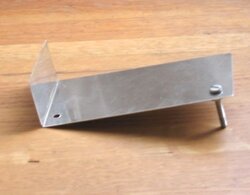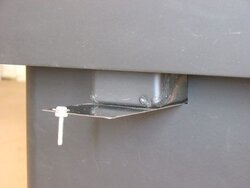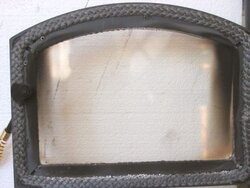Taming the wild Quadrafire 2100, part 2B
OK, lastly, I wanted to extend the life of the coals to the 7-8 hour range, so the fire can be revived the next morning without kindling or starting from scratch. Having done this to other stoves, there's no mystery that the key is to cut off almost all air to the firebox, giving only a small amount of "bleed" air to keep the coals alive but not enough that they burn off. Part of this was dealt with by removing the stop screw from the primary air control. We must also be able to shut off the secondary air, which is the largest air source in the stove.
Now, I must say... I really like having full control of the secondary air; it especially helps controlling the fire at lower burn rates. But the Quad 2100 has two separate secondary air inlets, on opposite sides of the stove (see photo 7.) Fabricating a sliding control for that is a bit of a pain. I'll deal with that in the off-season. For now, I'll settle for blocking plates so it can be shut off. I happened to have some thin pieces of stainless steel with a right angled bend on one end, so I cut them to size and added a screw for a handle (see photo 13.) In use, after the flames have died, these two pieces are slid closed on either side of the stove and the secondary is then shut off (see photo 14.)
OK, so now we've done things to (hopefully) slow down the burn rate, clean up the glass, make it burn more evenly in the firebox, and extended the life of the coals. So, how's it burn, Johnnie? Let's re-install it, fire it up and see. I'll watch the chimney from time to time to see if the changes have made things worse emissions-wise.
: The stove is now much more controllable. With complete control of the primary air, much lower burn rates can be had, up to 30% longer per load. And, if things get out of hand, it can now be shut down completely. I consider this an important safety feature.
: About half the time, some wood at the very back of the firebox does not burn. That means I reduced the size of the hole at the back too much. An easy fix.
: Even with the lower burn rates made possible by removing the primary stop screw, the glass cleanliness is improved (see photo 15, and compare to photos 1 and 3.) The sooted areas on both sides are smaller, and less dark as well. The left side has improved but is still worse than the right. And the right side has changed; it's cleaner now toward the bottom. That's a clue; maybe an air leak there.
: The swirl burn pattern is weaker but still present, as shown by the sooting on the glass.
: The coals bed can now easily be revived after 8 hours. Just open up the primary, open the door a little, and in a couple minutes you have a full bed of red hot coals for startup. Exactly what the doctor ordered!
: With smaller-diameter wood, there's still a tendency for this stove to "take off" about half way through the load, but not as bad a before. The cure is to use larger splits. When I cut my wood for next season, I'll be able to optimize it for the stove.
: I see no difference in smoke from the chimney after these mods. It's still a nice, clean-burning stove. (Though, I must say that, despite it's higher EPA numbers, the Morso 2110 burns cleaner...)
So - a definite improvement on all fronts, resulting in a stove that is burning better and is much more pleasant to use. Extending the burn time alone makes all the difference in the world. I can now see myself living with this stove.
But there's still the uneven burn problem. And possible evidence of an air leak near the bottom right of the door which could be partly to blame. In Part 3 I'll try to track those down and get this thing burning normally.
OK, lastly, I wanted to extend the life of the coals to the 7-8 hour range, so the fire can be revived the next morning without kindling or starting from scratch. Having done this to other stoves, there's no mystery that the key is to cut off almost all air to the firebox, giving only a small amount of "bleed" air to keep the coals alive but not enough that they burn off. Part of this was dealt with by removing the stop screw from the primary air control. We must also be able to shut off the secondary air, which is the largest air source in the stove.
Now, I must say... I really like having full control of the secondary air; it especially helps controlling the fire at lower burn rates. But the Quad 2100 has two separate secondary air inlets, on opposite sides of the stove (see photo 7.) Fabricating a sliding control for that is a bit of a pain. I'll deal with that in the off-season. For now, I'll settle for blocking plates so it can be shut off. I happened to have some thin pieces of stainless steel with a right angled bend on one end, so I cut them to size and added a screw for a handle (see photo 13.) In use, after the flames have died, these two pieces are slid closed on either side of the stove and the secondary is then shut off (see photo 14.)
OK, so now we've done things to (hopefully) slow down the burn rate, clean up the glass, make it burn more evenly in the firebox, and extended the life of the coals. So, how's it burn, Johnnie? Let's re-install it, fire it up and see. I'll watch the chimney from time to time to see if the changes have made things worse emissions-wise.
: The stove is now much more controllable. With complete control of the primary air, much lower burn rates can be had, up to 30% longer per load. And, if things get out of hand, it can now be shut down completely. I consider this an important safety feature.
: About half the time, some wood at the very back of the firebox does not burn. That means I reduced the size of the hole at the back too much. An easy fix.
: Even with the lower burn rates made possible by removing the primary stop screw, the glass cleanliness is improved (see photo 15, and compare to photos 1 and 3.) The sooted areas on both sides are smaller, and less dark as well. The left side has improved but is still worse than the right. And the right side has changed; it's cleaner now toward the bottom. That's a clue; maybe an air leak there.
: The swirl burn pattern is weaker but still present, as shown by the sooting on the glass.
: The coals bed can now easily be revived after 8 hours. Just open up the primary, open the door a little, and in a couple minutes you have a full bed of red hot coals for startup. Exactly what the doctor ordered!
: With smaller-diameter wood, there's still a tendency for this stove to "take off" about half way through the load, but not as bad a before. The cure is to use larger splits. When I cut my wood for next season, I'll be able to optimize it for the stove.
: I see no difference in smoke from the chimney after these mods. It's still a nice, clean-burning stove. (Though, I must say that, despite it's higher EPA numbers, the Morso 2110 burns cleaner...)
So - a definite improvement on all fronts, resulting in a stove that is burning better and is much more pleasant to use. Extending the burn time alone makes all the difference in the world. I can now see myself living with this stove.
But there's still the uneven burn problem. And possible evidence of an air leak near the bottom right of the door which could be partly to blame. In Part 3 I'll try to track those down and get this thing burning normally.




